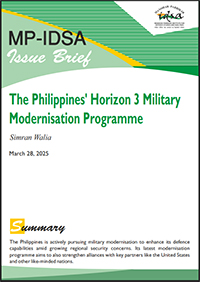The Philippines’ Horizon 3 Military Modernisation Programme
- March 28, 2025 |
- Issue Brief
Summary
The Philippines is actively pursuing military modernisation to enhance its defence capabilities amid growing regional security concerns. Its latest modernisation programme aims to also strengthen alliances with key partners like the United States and other like-minded nations.
The Philippines is in the third stage of its ‘Horizons’ military modernisation initiative. As part of the programme, the Philippines has set aside US$ 35 billion over the next 10 years. Amidst increasing tensions in the South China Sea (SCS), the Philippine military is eager to acquire at least two submarines and additional anti-ship missiles as part of its ongoing military modernisation programme.[1]
Background
During the rule of President Ferdinand Marcos (1965–1986), the Philippines underwent military expansion and modernisation. Still, much of this was geared towards internal security, particularly counterinsurgency efforts against the Communist Party of the Philippines (CPP) and the Moro National Liberation Front (MNLF). Defence priorities were focused more on regime stability rather than broader national defence.
By the late 1990s, tensions in the SCS began to escalate. China built a small structure on Mischief Reef in the SCS after seizing control of it in late 1994 or early 1995.[2] The Philippines depended on the United States for protection against external threats until the end of the US leases on military bases in the country, including Subic Bay and Clark Air Force Base, in 1991–1992.
President Ramos attempted to modernise the military in 1995 with the Armed Forces of the Philippines (AFP) Modernisation Act.[3] Ever since its inception, the Act has been revised to ensure the military remains capable of responding to national and regional security threats, both external and internal. The Act aims to enhance the capabilities of the Philippine military in terms of equipment, training and overall effectiveness. The primary goal is to modernise the Armed Forces of the Philippines by upgrading its defence capabilities, particularly to address emerging threats and challenges, such as terrorism, territorial defence and natural disasters.
By the time President Benigno Aquino took office in June 2010, the Philippine defence establishment was still ‘Southeast Asia’s military laggard’, despite the reforms and modernisation initiatives.[4] In 2011, the Aquino administration developed a new military policy that prioritised exterior territorial defence and internal security operations in response to Chinese aggression in the Philippines’ EEZ and Kalayaan Island group. The Philippine Congress set aside US$ 450 million, or around 1 per cent of GDP, for defence expenditures in March 2011.[5]
In 2012, the Philippine Congress passed the revised AFP Modernisation Act, which allocated significant funding for military upgrades. The Revised AFP Modernisation Act outlined a funding scheme over 15 years (2013–2027). The law mandated that the Philippine government allocate a portion of the national budget to fund the modernisation programme. This has led to an annual allocation, with the government committing significant funds towards the acquisition of new equipment, technologies and training for the military.
Aquino’s administration saw several significant events involving China, beginning in March 2011 when the Chinese threatened to ram a Philippine seismic ship and a five-month stalemate at Scarborough Shoal in April 2012.[6] Two civil supply ships that were supposed to transport supplies to the Philippine Marines on Second Thomas Shoal were halted by the Chinese Navy in March 2014. The Aquino administration ordered the AFP’s modernisation programme to be accelerated in response to the incidents, and ‘the protection of Philippine claims in the South China Sea’ was declared the country’s ‘highest external defence priority’.[7]
The Philippines Military Modernisation Programme is structured around a series of strategic horizons that guide the development of the AFP over time. The programme’s objective is to increase the Philippines’ capacity for self-defence and independence. It has three primary horizons, each focusing on specific priorities and progressively advancing the capabilities of the AFP.
The first Horizon’s timeframe was from 2013 to 2017, which focussed on the basic modernisation addressing immediate and critical gaps in the AFP’s capabilities, especially in terms of equipment and operational readiness.[8] Key focus areas under Horizon-1 were the acquisition of basic naval assets, procurement of light transport aircraft like the Bell 412, upgrading small arms and improving the AFP’s communication systems and command centres.
Horizon-2 of the modernisation programme was from 2018 to 2022 and was focussed on a more enhanced modernisation. It aimed to enhance the AFP’s defence capabilities through modernising equipment and addressing the growing threats in the region.[9] This included strengthening the naval force with the acquisition of additional missile-capable frigates, procurement of multi-role fighter jets and surveillance aircraft and acquisition of more advanced artillery systems, armoured vehicles and precision-guided munitions. The AFP had enhanced its ability to protect the country’s maritime territories and improve the readiness of its forces, but some key areas still required further upgrading.
Recent Endeavours
Since assuming office in 2022, President Ferdinand ‘Bongbong’ Marcos has vigorously resisted Chinese aggressiveness in the Philippine Exclusive Economic Zone (EEZ). Amid the growing SCS territorial conflicts, Defense Secretary Gilberto Teodoro Jr. declared the adoption of the third phase of the AFP Modernisation Programme, Revised Horizon (Re-Horizon) 3, on 23 January 2024. To fully secure and defend the nation’s land and water territory, exclusive economic zones, seabed, continental shelf, and air space, Re-Horizon 3 is a strategy that has a budget of US$ 35 billion spread over 10 years. The primary goal is to further enhance the country’s defence capabilities by acquiring advanced technology and systems to strengthen the AFP’s overall readiness.
This calculated action is the last in a three-phase upgrade process that began in 2013 as a result of rising SCS tensions brought on by China’s aggression. Re-Horizon 3 also entails acquiring resources to improve deterrence, command and control, intelligence, connectivity and communications. The Philippines is improving its air and sea defence capabilities through its defence modernisation agenda. The purchase of S-70 Black Hawk helicopters, missile corvettes, quick assault interdiction boats, and Wonhae-class Offshore Patrol Vessels (OPVs) are some of the significant ongoing initiatives.[10]
These purchases support the Philippine government’s larger defence modernisation efforts by addressing the major marine security domains, facilitating quick reaction, and enhancing reconnaissance and surveillance. Furthermore, the introduction of cutting-edge technology such as advanced missile systems, modern tanks and upgrades to artillery are the focus areas of the Re-Horizon 3 phase. The Philippine army is also seeking to acquire advanced anti-air and submarine warfare capabilities in response to the external threat posed by China.
This phase of the programme emphasises the procurement of multi-role fighter jets (MRFs), such as F-16s, FA-50PH upgrades, or next-generation platforms.[11] These aircraft would provide the capability for air superiority, ground attack missions, and multirole functions such as reconnaissance and surveillance. While the PAF’s acquisition of MRFs represents a positive development, continued investment in infrastructure, pilot training and future aircraft acquisitions will be critical to ensuring long-term effectiveness of the country’s air force. The enhancement of the nation’s capacity for maritime domain awareness is another important aspect of the updated horizon.
In addition to Re-Horizon 3, the Philippine defence authorities’ new Comprehensive Archipelagic Defense Concept (CADC) places more focus on the nation’s air and naval capabilities. It emphasises that it is crucial to safeguard the nation’s natural resources and ensure their peaceful, unhindered exploration. Patrols between the EEZ and the 7,641-island nations’ internal waterways are among the Philippine Navy’s missions.[12] Re-Horizon 3 aims to enable the implementation of the CADC. This new defence concept emphasises the protection of the Philippines’ archipelagic territory, focusing on securing its vast maritime domain, including the protection of territorial waters, islands and EEZs.
The Philippines has expanded defence procurement to countries including India, Israel, Poland, South Korea and Turkey, even though the US remains a major supplier due to long-standing military connections. Hyundai Heavy Industries, a South Korean shipbuilder, has been one of the AFP’s primary collaborators thus far. The company has already given the Philippine Navy two Jose Rizal-class frigates. In addition, Manila has ordered six offshore patrol boats and two missile corvettes from Hyundai, which should arrive this year. In 2019, South Korea also gave the Philippine Navy a Pohang-class corvette.
Furthermore, negotiations to acquire more BrahMos missile batteries are underway between Manila and New Delhi.[13] In April 2024, New Delhi delivered the first shipment of missiles. However, it is important to note that the Philippines would need to invest in developing a robust naval support system, including submarine bases, repair facilities, and trained personnel.
The ‘Re-Horizon’ phase of modernisation can be seen as a component of the Marcos administration’s strategy to fortify its security ties with the US, Japan, Canada, Australia, and other countries. As a result, the Philippines will have the capabilities necessary to meaningfully participate in regional and potentially global joint military exercises after this horizon is completed. Moreover, the new programme may also create chances for cooperation, particularly in developing the nation’s defence sector. National development can be greatly aided by agreements on professional exchanges, in-country production and technology transfer.
Going Forward
One of the challenges that was witnessed concerning the modernisation programm and enhancing defence capabilities was that of the financial budgets and whether the Philippines can afford to spend billions of dollars a year in modernising its military. The Philippines has historically had a relatively low defence budget compared to other countries in the region.
Although the government has made efforts to allocate more funds for military modernisation, the budget remains constrained by other national priorities, such as social programmes, education and infrastructure. This often results in delays and limitations in acquiring the required modern equipment and technology. In 2024, 40 billion pesos were allotted for defence modernisation. At the current currency rate, that amounts to almost US$ 694 million.[14] Therefore, to reach its expenditure target of US$ 35 billion, the government would have to work on expanding its resources significantly to be able to match the targeted expenditure for the country’s military modernisation.
In recent times, the Philippines has shown a strong interest in acquiring submarines as part of its efforts to modernise its military. They are seen as crucial tools in the fight against the Chinese Coast Guard and military vessels’ constant encroachment into Philippine territorial seas in the SCS. Submarines would enable the Philippine Navy to undertake stealth operations and extend its capabilities into the subsurface. They are especially well-suited for intelligence, surveillance and reconnaissance missions because they are hard to detect.
Although it was unclear until recently if the AFP could afford the cost of buying and maintaining a submarine fleet, Re-Horizon 3 has allocated between 80 billion and 110 billion pesos for the purchase of two submarines as well as the related logistical and basing needs.[15] The most likely partner would be France’s Naval Group, which has volunteered to train the personnel required to operate two Scorpène-class submarines. The submarines would be stationed in the former U.S. military facility in Subic Bay. With plans to purchase at least two squadrons of multi-role combat aircraft (MRCA), the AFP is preparing for a significant increase in air combat capability in addition to submarines.
Cooperation between the Philippine Coast Guard, the Philippine Navy, and the Bureau of Fisheries and Aquatic Resources (BFAR) becomes vital in the face of these rising tensions. These organisations can efficiently patrol the EEZ and enforce maritime rules by coordinating their efforts and pooling their resources.
Given the Philippines’ defence budget and the other priorities it must address, acquiring submarines would need to be strategically planned to fit within its broader modernisation goals. However, the pace of acquisition may depend on available funding, as other areas like air defence, naval vessels, and ground force modernisation are also competing for resources. Alternatively, it might be against the Philippines’ interests in maritime security to divert scarce resources to the purchase of submarines rather than constructing sufficient and competent surface platforms.
Overall, while earlier horizons focused on building the foundation of the military’s capabilities, Re-Horizon 3 aims to fully transition and align the AFP with a comprehensive defence strategy that prioritises territorial defence and deterrence against external threats.
Views expressed are of the author and do not necessarily reflect the views of the Manohar Parrikar IDSA or of the Government of India.
[1] “Philippines Pushes for ‘Dream’ Submarines as Global Defense Giants Battle for the Deal”, Defence Security Asia, 2 March 2025.
[2] Henry J. Kenny, “The South China Sea: A Dangerous Ground”, Naval War College Review, Vol. 49, No. 3, 1996, pp. 96–108.
[3] Carlyle A. Thayer, “Military Modernization and Capacity Building in the Philippines and Vietnam”, In the Wake of Arbitration: Papers from the Sixth Annual CSIS South China Sea Conference, Center for Strategic and International Studies (CSIS), 1 January 2017, pp. 95–110.
[4] Shang-su Wu, “Aquino’s Military Modernization: Unprecedented But Insufficient”, The Diplomat, 23 March 2016.
[5] Ibid.
[6] “Aquino Says Chinese Survey Ships Seen in Philippine Waters”, Reuters, 18 August 2014.
[7] Renato Cruz De Castro, “The Next Phase of Philippine Military Modernization: Looking to External Defence”, Asia Maritime Transparency Initiative, 12 July 2018.
[8] Andrew Drwiega, “Modernising The Philippines Armed Forces”, Asian Military Review, 19 April 2019.
[9] Renato Cruz De Castro, “The Next Phase of Philippine Military Modernization: Looking to External Defence”, no. 6.
[10] Lee Kok Leong, “Philippines Modernizes Military Amid Escalating South China Sea Crisis”, Maritime FairTrade, 28 March 2024.
[11] Mikhail Flores and Karen Lema, “Philippines Eyes Mid-range Missiles, 40 Fighter Jets to Modernise Military”, Reuters, 29 August 2024.
[12] Jeoffrey Maitem, “Philippines Launches ‘Surface Action Groups’ to Strengthen South China Sea Patrols and Defence”, South China Morning Post, 24 January 2025.
[13] Ashish Dangwal, “‘Crown Jewel’ of Indian Military — Philippines in Talks With Delhi to Buy More BrahMos Missiles: Reports”, Eurasian Times, 17 January 2025.
[14] James Guild, “The Philippines’ $35 Billion Military Modernization Plan, Explained”, The Diplomat, 17 May 2024.
[15] Priam Nepomuceno, “AFP Eyes 2 Subs to Beef Up Defensive Capabilities”, Philippine News Agency, 12 February 2025.





